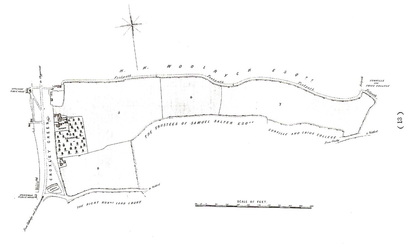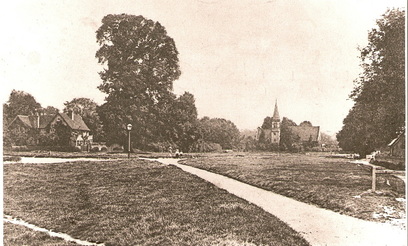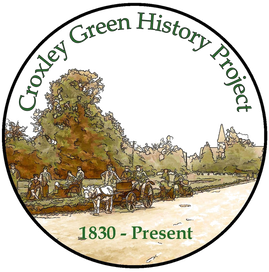Hollow Tree House Farm
In 1860 some 30 acres of land belonging to Hollow Tree House were acquired. The house, still to be found on The Green, had a farm estate that extended towards the Watford Road on one side and a cart track known as Cow Lane on the other side. At this time it was the main thoroughfare for, as the name suggests, taking the beasts from farms north of the village to pasture at Common Moor.
This land was sold for building in 1865. The relevant dwellings were to be built to specified criteria. This road was then improved, named Croxley Green New Road and small building plots sold to individual builders. A link road, Garden Road, connected Croxley Green New Road with Watford Road as the housing development continued. Garden Road was renamed Yorke Road in 1898 after local resident Charles Frederick Yorke who had held the position of chairman of Rickmansworth Urban District Council. He is listed in the 1901 census as a ‘colliery owner’ living at West View, New Road.
This land was sold for building in 1865. The relevant dwellings were to be built to specified criteria. This road was then improved, named Croxley Green New Road and small building plots sold to individual builders. A link road, Garden Road, connected Croxley Green New Road with Watford Road as the housing development continued. Garden Road was renamed Yorke Road in 1898 after local resident Charles Frederick Yorke who had held the position of chairman of Rickmansworth Urban District Council. He is listed in the 1901 census as a ‘colliery owner’ living at West View, New Road.
HOLLOW TREE HOUSE, THE GREEN - From The Croxley Green Resident issue 199 (1974)
Hollow Tree House, or Hollow Tree Farm as this property is described in the middle of the XVIII century is one of many properties that front the Green, all of ancient origin, that seem to be, by the pattern of their layout, to stretch back to mediaeval times or earlier. The acreage of the farm, given in the Tithe Charge Ren tal of 1840 is 35 acres, 1 rod, 2l perches, and the charges made against it are £ 2.4.4. to the Vicar and £6.13.1. to the Appropriator. The estate was bounded on its west side by the present Watford Road and on its east side by the present New Road. The farm was mainly arable in nature, just over 30 acres being under the plough, just over 3 acres of meadows, a little over 1 acre of woodland and the remaining land consisted of the farm house, yard, a cottage and gardens and a private roadway that gave access to a field called Milestone field, of 15 acres, owned by the Trustees of Salters Brewery in Rickmansworth.
At this time, 1840, the farm was in possession of Isaac Thomas Couchman, the land owner being Edward Thomas Munroe, who had come in to possession! of the estate in 1820. It had previously. been in the possession of Elizabeth Whitfield who had been admitted to the property in May 1795. The previous land owner had been Thomas Whitfield and his name is shown as its possessor in a survey of the Manor of Gonville & Caius College and dated 1770, but records available show that he did not occupy the property neither did the previous possessor a Mr Willett, who was in possession as early as 1692, it always appears to have been rented. Munroe enfranchised the property in May 1856 and in February l860an agreement was made with the British Land Co. Ltd. for the sale of part of the land which is now New Road, this land was then divided up into building plots and a sale was held of these plots at the Swan Inn, Rickmansworth, in March 1865, the price paid for one of these plots suitable for a cottage was £20, the house erected on this site had to conform to the following stipulation laid down by the Company that the "net first cost of which in materials and labour of construction only. estimated at the lowest current prices shall be not less than £150". The British Land Co. Ltd. was a subsidiary company of the National Freehold Land Society which had been formed in 1849, with the two Chief Architects of the freehold land movement Richard Cobden and John Bright on its board. By the middle of the 1850's it handled well over one hundred estates of varying sizes up to 250 acres at a total cost of over a half million pounds. The Society was very active in the suburbs of London and it began the practice of inviting tenders from builders for erecting houses on its estates. Expansion of this business however was hampered by the law of mortmain which prevented freehold societies from holding land even for the purpose of dividing it and reselling it. When general limited liability became available in lS56, the Society seized its chance of forming a joint stock subsidiary to perform this function. This was the beginning of the largest land company to operate in London generally during the 19th century - The British Land Co. Ltd. The purpose of this Company was to buy and sell land and to develop building estates of which purchasers of plots could have houses built by means of mortgage loans from the National Freehold Land Society; the parent company was prepared to advance the whole of the price of the land and two-thirds of the value of the property building. This was a facility which was naturally welcome to small speculative builders, and the growth of London su burbs bear witness to the activities of this Company and to New Road in particular. No doubt the interest shown by
the Company in purchasing land belonging to Hollow Tree Farm was due in the first instance by the linking of Watford to Euston by the railway and also to the
building of the Watford -- Rickmansworth Railway by Lord Ebury and his associates, railway development usually meant a demand for homes and in an age when land was bound up in large estates, the opportunity to purchase an area large enough for development could not be slighted.
What is of interest is that the area now forming New Road was the first large area that was developed for building houses in this district. The occupiers of Hollow Tree Farm were small farmers, of their private lives very little can be learned today, one or two of them were important locally, the remainder are just names, recorded in the rate accounts of the 17th, 18th or early 19th century, each paying their due when the Overseer called each quarter day. The most important occupier of the farm was Stephen Salter, Brewer of Rickmansworth. The Salter family first appear to local records in 1727, and appear to have gone into partnership with a brewer named Woodman. The business flourished and they began to purchase public houses in the town. He leased the farm in l758 and relinquished it in 1769. when it passed to Christopher Leach, the younger who was still in occupation in 1804. this period of 35 years was the longest tenancy eyer held by one man. Unfortunately, however,
it seems to have been the practice for the eldest son to have the same christian name as the father and in connection with the name Christopher Leach is a story. that he fell out of a cart and due to the accident died, the horse being seized as deodands by the Lord of the Manor for having caused the death of Christopher. The Leach family, having held property in Croxley Green since the early part of the 18th Century and the manorial records not being available locally, it is difficult to ascertain which Christopher died because of the accident. Solomon Andronin, who occupied the farm, purchased the site on which now stands Croxley House, he bought it from Richard
Tuffen in 1737 and sold it in 1767 to Thomas, Lord Hyde, afterwards Earl of Clarendon. Andronin remained in occupation of Hollow Tree Farm until 1740 when it was sold to John Woodbridge. What is of interest about the Wood bridge family is that they were in occupation from 1692 until 1711, when the occupier was Thomas Bovingdon, who stayed until 1721, when Henry Fawcett took over occupation. In 1727 he was followed by a woman Rebecca How who farmed the land until 1735.
Between 1748 and 1758, the farm was leased to Daniel Bovingdon of Croxley Hall farm. In 1851, the occupier was Thomas Ansell who was in occupation in 1862. The lack of local records prevents the completion of the record of occupiers of Hollow Tree House, these could be found by consultation of Directories, but these are not available locally. However, it does not need a directory to tell who the owners are today. By an odd coincidence the name Leach is back at Hollow Tree House. Dr and Mrs R.H. Leach have very skill fully adapted the house to modern living and yet have kept the character of the house.
Hollow Tree House, or Hollow Tree Farm as this property is described in the middle of the XVIII century is one of many properties that front the Green, all of ancient origin, that seem to be, by the pattern of their layout, to stretch back to mediaeval times or earlier. The acreage of the farm, given in the Tithe Charge Ren tal of 1840 is 35 acres, 1 rod, 2l perches, and the charges made against it are £ 2.4.4. to the Vicar and £6.13.1. to the Appropriator. The estate was bounded on its west side by the present Watford Road and on its east side by the present New Road. The farm was mainly arable in nature, just over 30 acres being under the plough, just over 3 acres of meadows, a little over 1 acre of woodland and the remaining land consisted of the farm house, yard, a cottage and gardens and a private roadway that gave access to a field called Milestone field, of 15 acres, owned by the Trustees of Salters Brewery in Rickmansworth.
At this time, 1840, the farm was in possession of Isaac Thomas Couchman, the land owner being Edward Thomas Munroe, who had come in to possession! of the estate in 1820. It had previously. been in the possession of Elizabeth Whitfield who had been admitted to the property in May 1795. The previous land owner had been Thomas Whitfield and his name is shown as its possessor in a survey of the Manor of Gonville & Caius College and dated 1770, but records available show that he did not occupy the property neither did the previous possessor a Mr Willett, who was in possession as early as 1692, it always appears to have been rented. Munroe enfranchised the property in May 1856 and in February l860an agreement was made with the British Land Co. Ltd. for the sale of part of the land which is now New Road, this land was then divided up into building plots and a sale was held of these plots at the Swan Inn, Rickmansworth, in March 1865, the price paid for one of these plots suitable for a cottage was £20, the house erected on this site had to conform to the following stipulation laid down by the Company that the "net first cost of which in materials and labour of construction only. estimated at the lowest current prices shall be not less than £150". The British Land Co. Ltd. was a subsidiary company of the National Freehold Land Society which had been formed in 1849, with the two Chief Architects of the freehold land movement Richard Cobden and John Bright on its board. By the middle of the 1850's it handled well over one hundred estates of varying sizes up to 250 acres at a total cost of over a half million pounds. The Society was very active in the suburbs of London and it began the practice of inviting tenders from builders for erecting houses on its estates. Expansion of this business however was hampered by the law of mortmain which prevented freehold societies from holding land even for the purpose of dividing it and reselling it. When general limited liability became available in lS56, the Society seized its chance of forming a joint stock subsidiary to perform this function. This was the beginning of the largest land company to operate in London generally during the 19th century - The British Land Co. Ltd. The purpose of this Company was to buy and sell land and to develop building estates of which purchasers of plots could have houses built by means of mortgage loans from the National Freehold Land Society; the parent company was prepared to advance the whole of the price of the land and two-thirds of the value of the property building. This was a facility which was naturally welcome to small speculative builders, and the growth of London su burbs bear witness to the activities of this Company and to New Road in particular. No doubt the interest shown by
the Company in purchasing land belonging to Hollow Tree Farm was due in the first instance by the linking of Watford to Euston by the railway and also to the
building of the Watford -- Rickmansworth Railway by Lord Ebury and his associates, railway development usually meant a demand for homes and in an age when land was bound up in large estates, the opportunity to purchase an area large enough for development could not be slighted.
What is of interest is that the area now forming New Road was the first large area that was developed for building houses in this district. The occupiers of Hollow Tree Farm were small farmers, of their private lives very little can be learned today, one or two of them were important locally, the remainder are just names, recorded in the rate accounts of the 17th, 18th or early 19th century, each paying their due when the Overseer called each quarter day. The most important occupier of the farm was Stephen Salter, Brewer of Rickmansworth. The Salter family first appear to local records in 1727, and appear to have gone into partnership with a brewer named Woodman. The business flourished and they began to purchase public houses in the town. He leased the farm in l758 and relinquished it in 1769. when it passed to Christopher Leach, the younger who was still in occupation in 1804. this period of 35 years was the longest tenancy eyer held by one man. Unfortunately, however,
it seems to have been the practice for the eldest son to have the same christian name as the father and in connection with the name Christopher Leach is a story. that he fell out of a cart and due to the accident died, the horse being seized as deodands by the Lord of the Manor for having caused the death of Christopher. The Leach family, having held property in Croxley Green since the early part of the 18th Century and the manorial records not being available locally, it is difficult to ascertain which Christopher died because of the accident. Solomon Andronin, who occupied the farm, purchased the site on which now stands Croxley House, he bought it from Richard
Tuffen in 1737 and sold it in 1767 to Thomas, Lord Hyde, afterwards Earl of Clarendon. Andronin remained in occupation of Hollow Tree Farm until 1740 when it was sold to John Woodbridge. What is of interest about the Wood bridge family is that they were in occupation from 1692 until 1711, when the occupier was Thomas Bovingdon, who stayed until 1721, when Henry Fawcett took over occupation. In 1727 he was followed by a woman Rebecca How who farmed the land until 1735.
Between 1748 and 1758, the farm was leased to Daniel Bovingdon of Croxley Hall farm. In 1851, the occupier was Thomas Ansell who was in occupation in 1862. The lack of local records prevents the completion of the record of occupiers of Hollow Tree House, these could be found by consultation of Directories, but these are not available locally. However, it does not need a directory to tell who the owners are today. By an odd coincidence the name Leach is back at Hollow Tree House. Dr and Mrs R.H. Leach have very skill fully adapted the house to modern living and yet have kept the character of the house.




